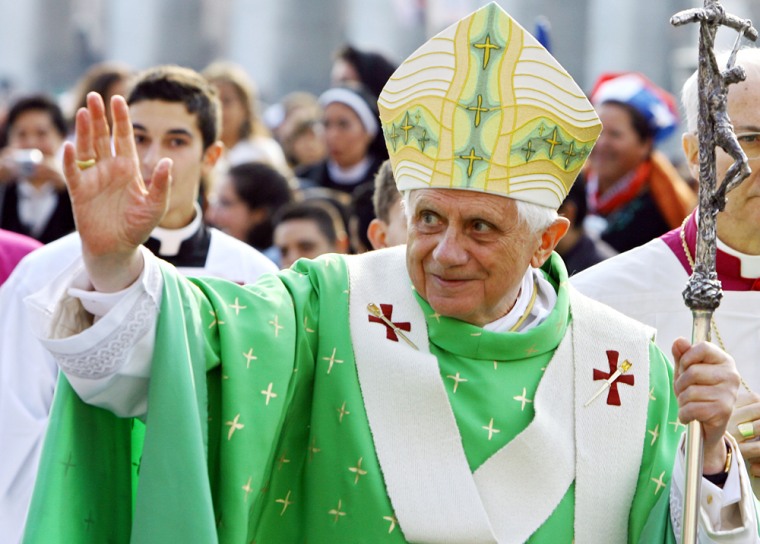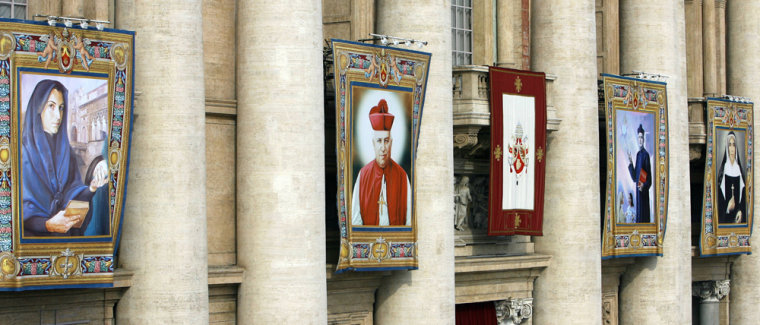Pope Benedict XVI gave the Catholic Church new saints Sunday, bestowing the Church's highest honor in a ceremony in St. Peter's Square on four faithful from past centuries whose lives he hopes will inspire courage in today's followers.
The new saints are a French woman who set up a chapel in a log cabin in the American frontier land and went on to establish a girls' college; a Mexican bishop who risked persecution to educate seminarians; a nun who promoted public schooling for girls in Italy, and an Italian priest who helped the deaf.
"The Church rejoices in the four new saints," Benedict told a crowd of several thousand at the end of the two-hour ceremony. "May their example inspire us and their prayers obtain for us guidance and courage."
Midwest prelates come to Vatican City
Among those celebrating the Mass on the steps of St. Peter's Basilica were prelates based in the U.S. Midwest, including ailing Chicago Cardinal Francis George and five churchmen from Indiana, where Mother Theodore Guerin, who is one of the four new saints, established a college for women, which enrolled its first student in 1841.
George, along with hundreds of alumnae, trustees and students of St. Mary-of-the-Woods College in Indiana, flew to Rome for the ceremony. The cardinal is recovering from bladder cancer surgery he had in late July. The pope and the cardinal embraced at the altar shortly after George recited part of the Mass near Communion time.
Guerin, a frail and sickly woman known for her determination, endured harsh conditions on what was American frontier land in the early 1800s and resisted the objections of a local bishop in pursuing her dream of establishing Catholic education for the pioneers.
Benedict told the crowd that after a long journey by sea and land, Guerin, who was born in Brittany in 1798, and five other French nuns, turned a log cabin into a chapel. By the time of her death in 1856, her order was running schools and orphanages in Indiana, the pope noted.
Young people from the Indiana delegation waved blue scarves when the pope praised Guerin. Many of them wore T-shirts with Guerin's image.
‘The roll call of the saints’
The pope also elevated to sainthood Bishop Rafael Guizar Valencia, a missionary who was a great uncle of the Rev. Marcial Maciel Degollado, the founder of the Legionaries of Christ order of priest whom the Vatican restricted from public ministry this year amid allegations he had sexually abused seminarians. Guizar Valencia died in 1938. The bishop, sometimes disguising himself as a street vendor or a musician, risked his life to tend to the wounded during the Mexican revolution.

Benedict hailed Guizar Valencia for working tirelessly in "the beloved Mexican nation," even facing persecution, to ensure that seminarians were properly educated "according to the heart of Christ."
Faithful in Mexico say that the bishop's body showed remarkably little signs of decay after being removed from burial ground in a cemetery and put on display in the local cathedral some 12 years after his death.
"We register them in the roll call of the saints and we establish that in all the Church they will be devotedly honored among the saints," the pontiff said, as he read the canonization ritual in Latin.
Benedict, wearing bright green robes and seated under a canopy near the altar, smiled warmly.
Italians also canonized
Two Italians joined the ranks of sainthood as the Church gives fresh role models to its faithful.
The Rev. Filippo Smaldone, who lived from 1848-1923, pioneered education and other assistance for the deaf and founded an order of nuns, the Congregation of the Salesian Sisters of the Sacred Hearts. The order has convents in Brazil, Moldova, Paraguay and Rwanda.
Rosa Venerini was another social pioneer, advocating education for young girls in Italy. Living from 1656-1728, she founded the Congregation of the Holy Venerini Teachers order of nuns and pushed to establish the first public schools for girls in Italy.
"Their names will be remembered forever," Benedict said of the saints, as he began his homily to the applause of several thousands of faithful in the square.
It was Benedict's first canonization ceremony in nearly a year.
His predecessor, John Paul II, led several canonization and beatification ceremonies yearly, but Benedict has departed from that practice, taking a less visible approach. Ceremonies for beatification, the last formal step before sainthood, are now held in the country where the faithful lived or worked, and the services are led by local prelates.
Members of Guerin's religious order, the Sisters of Providence of St. Mary-of-the-Woods, described the nun's life story as an inspiration for the faithful when the Church was shaken by sexual abuse scandals.
